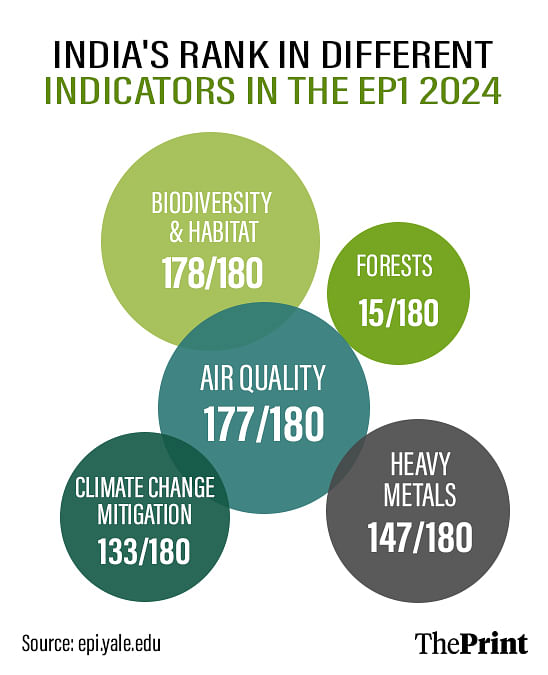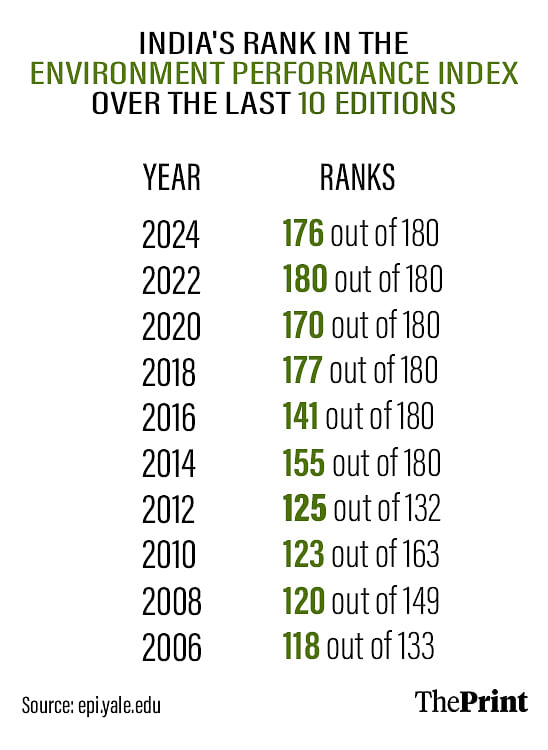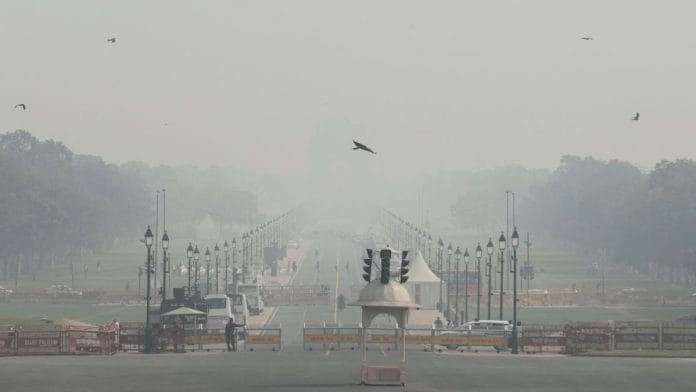New Delhi: India, the third largest emitter of greenhouse gases, was placed among the lowest-rung countries in air quality, projected emissions, and biodiversity and habitat in the 2024 Environment Performance Index (EPI).
India ranked 176th among 180 countries, above Pakistan, Vietnam, Laos, and Myanmar only, in the overall index, released 5 June by the Yale Center for Environmental Law and Policy and the Columbia Center for International Earth Science Information Network. This is a mild improvement to the last EPI in which India came at the bottom.
The 2024 EPI has 58 indicators, including biodiversity, air pollution, air and water quality, waste management, emission growth rates, projected emissions, etc., under the three main heads of ecosystem vitality, environmental health and climate change. Among these three heads, India does not rank among the bottom ten countries only in climate change.
This year, the EPI introduced the biodiversity and habitat category to check how countries have been protecting their existing biodiversity and ecosystems and finding that many protected areas in countries have buildings or croplands encroaching on them.
India’s performance lags in several indicators mainly because of its heavy dependence on coal, which contributes to not only greenhouse gas (GHG) emissions but also high air pollution levels. In air quality, India ranks 177th, above Pakistan, Bangladesh and Nepal only, and in projected emissions by 2025, it ranks 172nd.

In South Asia, which, as a region, ranks the lowest on the EPI, India is the biggest emitter of transboundary pollution, which affects Bangladeshi residents, the report found. Among the eight regions the report considered, the Global West and Eastern Europe emerge at the top and Sub-Saharan Africa and Southern Asia at the bottom.
The EPI also ranks India 178th, above China and Micronesia only, but the report clarifies this could be because of the unavailability of data. India, China and Turkey have restricted access to 95% of their submissions to the World Database of Protected Areas, so the EPI could not accurately assess their performance in this category.
The report said that India secured a better rank (133) in climate change, mainly because it has made advancements in investing in renewable energy and its goal towards transition to net-zero emissions by 2070, according to the report.
The report, however, said, “India will require an additional $160 billion per year in climate change mitigation investments to achieve its goals.”
Categories like solid waste management, forests, and agriculture are where India performed relatively better. However, abysmal scores in the air quality, emissions, and biodiversity categories brought down its overall performance.
Also read: Delhi wetlands going extinct. To be found in govt files only
Not the first time
This is not the first time that India has scored low on the Environment Performance Index, which has been producing reports since 2002. The last EPI in 2022 ranked India at the bottom because of low scores in nearly the same indicators.

The projected greenhouse gas emissions indicator, added in 2022 for the first time, measured whether countries were on track to achieve net-zero emissions of CO2, methane, fluorinated gases and nitrous oxide by 2050, with India, at that time, ranking in the bottom 10 as well. India, in 2022, also scored low on lead pollution, drinking water pollution, and protection of terrestrial biomes.
However, the Ministry of Environment, Forests and Climate Change, in 2022, ‘rejected’ the Environment Protection Index, saying it is “based on unfounded assumptions”. The main problems pointed out by the MOEFCC were that the report did not include India’s wetlands and forests, which are carbon sinks, and that the projected greenhouse gas emissions indicator was developed by modelling past emissions of only 10 years. The ministry also said that the indicators were assigned arbitrary weightage without explanation.
These issues with EPI 2022 were also by independent researchers, including Chandra Bhusan, CEO of iForest thinktank, who told Mongabay in 2022 that the EPI “has too much subjectivity. Their choice of indicators, weightages and even the ranking methodology has problems.”
Estonia edges out Denmark
The EPI is released once every two years to assess the performance of countries in achieving the targets of the UN Sustainable Development Goals, Paris Agreement 2015, and most recently, the Kunming-Montreal Global Biodiversity Framework 2022 — key climate change mitigation measures globally.
Based on all the 58 indicators, the number one country in the index is Estonia, which decreased its greenhouse gas emissions by 59% compared to 1990 levels, the report found.
Another reason that Estonia is at the top, ahead of Denmark, the top country in 2022, is because of its good ranking on the biodiversity and habitat indicator that shows the status of protected areas in the country — 20% of its lands and seas are protected areas.
“The 2024 Environmental Performance Index highlights a range of critical sustainability challenges from climate change to biodiversity loss and beyond — and reveals trends suggesting that countries across the world need to redouble their efforts to protect critical ecosystems and the vitality of our planet,” said Daniel C. Esty, director of Yale College of Environment Law and Policy, in a press release.
(Edited by Madhurita Goswami)
Also read: A new think tank on climate policy believes ‘sustainable development & job creation can go together’






